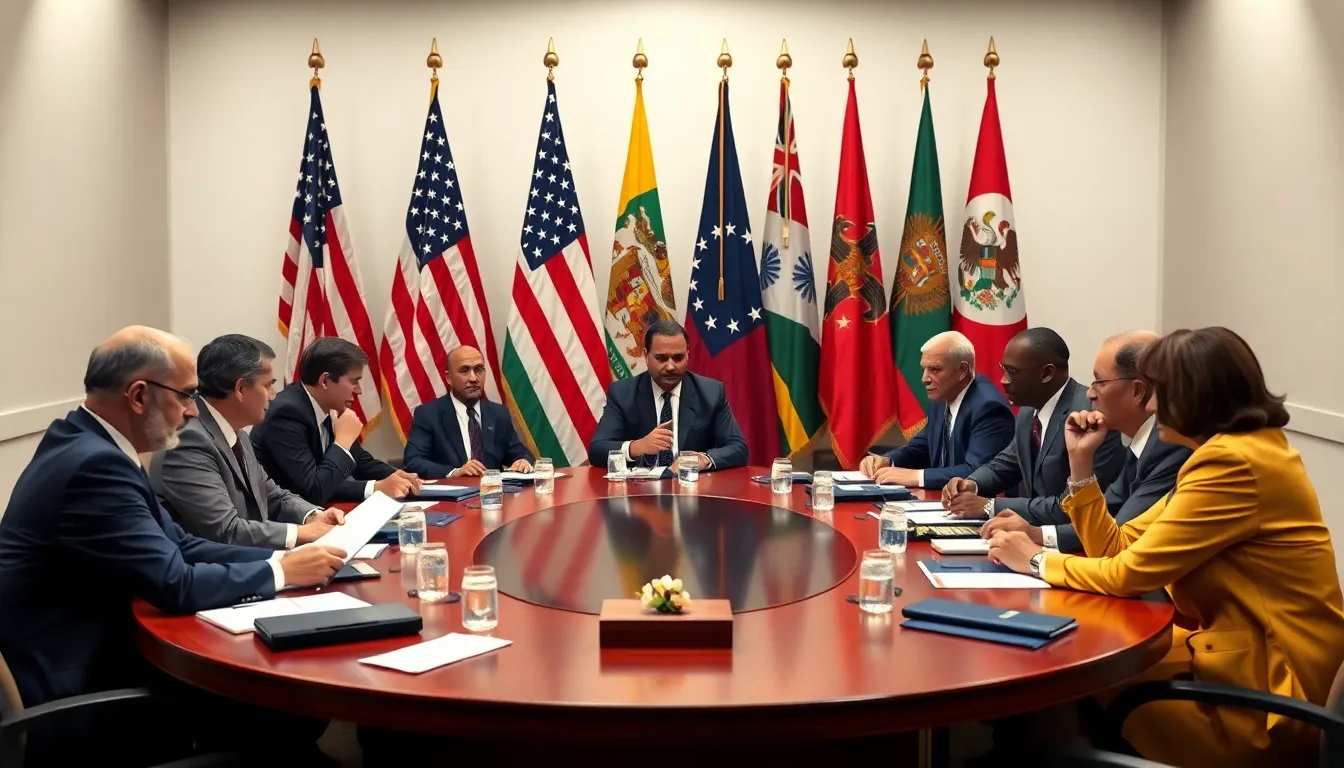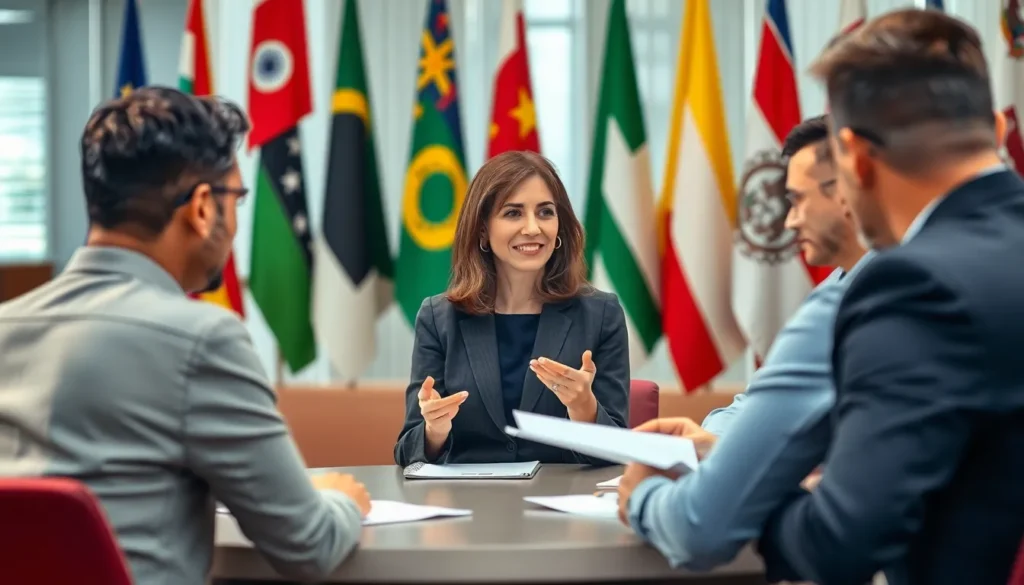Table of Contents
ToggleIn an increasingly interconnected world, conflicts arise from cultural, political, and economic tensions. These disputes can escalate, causing significant harm to communities and nations alike. Understanding the dynamics of conflict resolution is crucial for fostering peace and stability on a global scale.
World conflict resolution encompasses various strategies aimed at addressing disputes and promoting dialogue. From diplomatic negotiations to grassroots initiatives, effective resolution methods can transform hostility into cooperation. As global citizens, recognizing the importance of these approaches can empower individuals and nations to work towards a more harmonious future.
Understanding World Conflict Resolution
World conflict resolution involves methods and processes aimed at addressing and resolving disputes between communities, nations, and cultures. Effective resolution fosters global peace and enhances stability.
Definition and Importance
Conflict resolution refers to the systematic approach to mitigating disputes and fostering cooperation among conflicting parties. Its significance lies in reducing violence, preserving human rights, and ensuring sustainable development. Effective conflict resolution enhances relationships, builds trust, and promotes mutual understanding. Recognizing early warning signs of conflicts enables timely intervention, ultimately leading to a stable and peaceful society.
Theories of Conflict Resolution
Various theories inform the practice of conflict resolution, providing frameworks for understanding and addressing disputes:
- Interest-Based Theories: Address underlying interests rather than positions, promoting the identification of common goals and facilitating compromise.
- Human Needs Theory: Emphasizes the fulfillment of basic human needs, such as security and recognition, as essential for resolving conflicts.
- Social Constructionism: Suggests that conflicts arise from social constructs and narratives, encouraging dialogue to reshape perceptions and foster understanding.
- Conflict Transformation: Focuses on changing the underlying social structures and relationships that contribute to conflict, aiming for a deeper, more sustainable resolution.
Adopting these theories enables a comprehensive approach to resolving conflicts, ensuring compatible solutions for all parties involved.
Historical Context of World Conflicts

Historical conflicts inform the dynamics of contemporary disputes. Understanding major conflicts and the lessons learned from their resolutions enhances the approach to current conflict resolution strategies.
Major Conflicts in History
- World War I (1914-1918)
World War I involved numerous countries and resulted in significant loss of life and geopolitical changes. The Treaty of Versailles aimed to establish peace but created economic hardships for Germany, laying groundwork for future conflicts.
- World War II (1939-1945)
World War II emerged from unresolved issues of World War I, including economic instability and territorial disputes. Key outcomes included the establishment of the United Nations, which aimed to prevent future conflicts through cooperative dialogue.
- Cold War (1947-1991)
The Cold War represented ideological conflicts between the United States and the Soviet Union. Proxy wars and diplomatic tensions highlighted the urgency of maintaining peace, leading to arms control agreements and disarmament initiatives.
- Rwandan Genocide (1994)
The Rwandan Genocide showcased the catastrophic consequences of ethnic tensions. International failure to intervene and subsequent global awareness emphasized the need for effective preventive measures and timely conflict resolution strategies.
- Balkan Wars (1990s)
The Yugoslav Wars underscored the complexities of national identity and ethnic conflicts. The Dayton Agreement brought relative peace, illustrating the necessity of inclusive dialogues in addressing deeply rooted grievances.
Lessons Learned from Past Resolutions
- Importance of Early Intervention
Early diplomatic efforts often prevent the escalation of conflicts. Timely engagement by mediators can diffuse tensions before they lead to violence.
- Need for Inclusive Solutions
Comprehensive resolutions involve addressing the interests of all stakeholders. Successful peace processes consider diverse perspectives to ensure lasting harmony.
- Significance of Reconciliation Processes
Post-conflict reconciliation plays a crucial role in healing communities. Building trust through dialogue and cooperation fosters social cohesion and sustainable peace.
- Role of International Cooperation
Global collaborations enhance conflict resolution efforts. Multinational organizations, such as the United Nations, facilitate dialogue, mediation, and assistance in rebuilding war-torn regions.
- Recognition of Human Rights
Prioritizing human rights within conflict resolution frameworks leads to more equitable outcomes. Ensuring the protection of vulnerable populations mitigates the risk of recurring conflicts.
Approaches to Conflict Resolution
Several strategies exist for resolving conflicts effectively, each contributing to global peace. Understanding these approaches facilitates collaboration and mutual understanding among conflicting parties.
Diplomatic Strategies
Diplomatic strategies encompass formal negotiations, dialogue facilitation, and mediation. These approaches prioritize communication to address disputes between nations or groups. Key elements include:
- Negotiation: Parties engage directly to discuss terms and potential compromises. Successful negotiations often require skilled diplomats to bridge gaps.
- Mediation: An impartial third party assists conflicting parties in reaching an agreement. Mediation fosters cooperation, with professionals trained in conflict resolution techniques guiding discussions.
- Arbitration: An external entity listens to both sides, evaluates evidence, and renders a binding decision. This approach offers a clear resolution when negotiations stall.
Role of International Organizations
International organizations play a crucial role in conflict resolution efforts. Their involvement includes:
- Facilitating Dialogue: Organizations like the United Nations (UN) or the African Union (AU) promote communication channels among nations, fostering cooperative environments.
- Providing Expertise: Specialized agencies enhance conflict resolution initiatives through research, training, and providing resources. They offer strategies based on best practices in conflict management.
- Monitoring Agreements: International bodies often oversee adherence to peace agreements, ensuring compliance and minimizing the likelihood of renewed conflict. Monitoring increases accountability and builds trust among parties.
These approaches to conflict resolution contribute to understanding and addressing disputes on a global scale, illustrating the importance of proactive measures in fostering lasting peace.
Case Studies in World Conflict Resolution
Understanding conflict resolution through case studies reveals effective strategies and ongoing challenges. The examination of historical resolutions provides insights into current practices and the complexities inherent in global disputes.
Successful Resolutions
Successful resolutions often demonstrate the effectiveness of negotiation and collaborative efforts. Notable examples include:
- Camp David Accords (1978): These agreements between Egypt and Israel, facilitated by U.S. President Jimmy Carter, led to a peace treaty that remains in effect today. Both nations recognized each other’s sovereignty, significantly reducing regional tensions.
- Good Friday Agreement (1998): This accord ended decades of conflict in Northern Ireland. The agreement established a power-sharing government and addressed issues of national identity, leading to substantial political progress and reduced violence.
- South Africa’s Transition (1994): The peaceful transition from apartheid to a democratic government exemplifies successful conflict resolution involving negotiations led by Nelson Mandela and Cyril Ramaphosa. The Truth and Reconciliation Commission promoted healing and forgiveness.
- Colombian Peace Process (2016): The peace deal between the Colombian government and the FARC rebel group ended a 52-year conflict. Key components included transitional justice and rural development, addressing root causes of the conflict.
Ongoing Conflicts and Challenges
Ongoing conflicts present significant challenges to resolution efforts. Some examples include:
- Syrian Civil War: This conflict, ongoing since 2011, involves multiple factions and external influences, complicating resolution efforts. Humanitarian crises and displaced populations create urgent needs that require attention while political solutions remain elusive.
- Israeli-Palestinian Conflict: Deep-rooted historical grievances and territorial disputes hinder progress toward a lasting peace. Various negotiations have failed to produce a consensus, illustrating the complexities involved in addressing divergent national aspirations.
- Yemen Conflict: The multi-party war in Yemen has led to one of the world’s worst humanitarian crises. Efforts for negotiation face challenges due to the influence of regional powers and internal divisions, emphasizing the need for a comprehensive and inclusive approach.
- Myanmar’s Ethnic Conflicts: Ongoing violence against ethnic minorities, particularly the Rohingya, poses immense humanitarian challenges. Efforts to achieve reconciliation and peace face resistance from political powers, highlighting the intricacies of achieving lasting solutions.
These case studies underscore the importance of tailored strategies in conflict resolution and the need for persistent efforts to address ongoing challenges.
Future Trends in World Conflict Resolution
Future trends in world conflict resolution focus on innovative strategies and collaborative frameworks that address the complexities of global disputes.
Innovations and Technology
Innovations in technology enhance conflict resolution methods, offering new tools for dialogue and mediation. Digital platforms facilitate communication between conflicting parties, making it easier to share perspectives and build trust. Artificial intelligence (AI) analyzes data from historical conflicts, providing insights that can predict potential flashpoints. Augmented and virtual reality (AR/VR) tools enable immersive experiences that foster empathy among conflicting groups, allowing individuals to witness alternative narratives firsthand. These emerging technologies not only streamline processes but also encourage inclusive participation by broadening access to conflict resolution resources.
Global Cooperation Initiatives
Global cooperation initiatives aim to unite nations in addressing conflicts through collective action. Multilateral frameworks, such as the United Nations’ Sustainable Development Goals (SDGs), promote peaceful societies by incorporating conflict resolution into developmental agendas. Regional organizations, like the African Union and the European Union, facilitate dialogue and collaboration among member states to resolve disputes proactively. Joint humanitarian efforts, like those observed during international crises, demonstrate how shared interests can foster unity against common threats. These initiatives reinforce the importance of cooperative problem-solving, ensuring that diverse voices contribute to peacebuilding efforts on a global scale.
World conflict resolution remains a vital endeavor in today’s interconnected society. By embracing diverse strategies and fostering collaboration among nations and communities, it’s possible to transform conflicts into opportunities for growth and understanding. The lessons learned from historical and contemporary disputes highlight the necessity of inclusive approaches that respect human rights and address fundamental needs.
As technology continues to evolve, new avenues for dialogue and empathy will emerge, enhancing conflict resolution efforts. The commitment to proactive measures and international cooperation will be essential in building a more peaceful future. By prioritizing these principles, individuals and nations can contribute to a global environment where conflicts are resolved constructively, paving the way for sustainable peace and stability.





